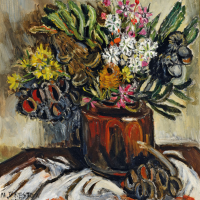32. MARGARET PRESTON

In Banksia 1955, Margaret Preston celebrates the inherent unruliness of our native flora, presenting a uniquely Australian approach to still-life. The serrated, leathery leaves, open-mouthed seed pods and sturdy, conical flowers of the banksia are interspersed with pink and yellow wildflowers in a jumbled, massed display. Prestons robust native forms are not pretty in a traditional sense instead, the flowers appear of the earth; the tangible products of a harsh and ancient land.1 Preston admired the unconventional beauty of Australian flora, remarking that Each flower is individual They never respond to being turned into bouquets, as roses and violets do.2
Over three decades of painting and printmaking, the banksia was one of Prestons most prolific and enduring subjects. The artist appears to have delighted in the exuberant otherworldliness of this plant, which readily lent itself to Prestons modernist sensibility for colour, pattern and form.3 Indeed, the most important stylistic developments in Prestons art may be effectively traced through her depiction of the banksia from the more geometrically contained compositions of the late 1920s (as seen in Banksia 1927 at the National Gallery of Australia), to the deliberately loose and expressive brushwork of Banksia 1955. Prestons defining image of the banksia is undoubtedly her woodblock design, WA Banksia c1929, in which the simplified, architectonic form of the plant acquires an almost totemic presence.4
Prestons paintings of the 1950s serve to challenge conventional notions of a linear artistic progression, marking a decisive shift from her aboriginal-inspired designs and tonal landscapes of the 1940s in favour of subjects and formal devices that were central to her art in earlier decades.5 Deborah Edwards description of Prestons approach to still-life painting in the 1930s could equally apply to the present work:
She focused on plant forms as they appeared evolved from the land, yet she also produced paintings which did not forgo the concept of the arrangement: flowers were still cut and brought inside to be painted If her realism was serviced by a looser, more textured treatment, this development was also allayed by a number of flattened decorative designs. Alongside paintings associated with Braques restricted grey/green palette, Preston painted in local ranges of colour.6
When Margaret Preston painted Banksia, her reputation as the most formidable Australian artist of her generation had been firmly established, leading Daniel Thomas to declare upon her death in 1963 that Preston was, without a doubt, the best painter working anywhere in Australia between the wars.7 Holding what was to be her final solo exhibition at the Macquarie Galleries in 1953, Preston continued to participate in major group exhibitions throughout the decade, between extended periods of travel to Europe, the Middle East, Africa and Southern Asia.
While conceding that the artists output gradually receded with age, one curator nevertheless points to recurring flashes of brilliance in Prestons art of the 1950s, where the freedom of paint exuded a confidence and vigour, and the vibrant spectrum of colour endowed her subjects with an expressive power that extended and challenged the traditions of the still-life genre in Australia.8 Banksia 1955 is an exceptional work of its time, revealing Prestons continued ability to generate visual interest through masterful deployment of colour and form.
Footnotes
1. Edwards, D. et al, Margaret Preston, Art Gallery of New South Wales, Sydney, 2005, p.154
2. Butel, E., Margaret Preston, Penguin Books, Sydney, n. p.
3. Edwards, D. et al, Margaret Preston, p.133
4. Ibid., p.127
5. Smith, G., Adam and Eve in the Garden of Eden, in Edwards, D. et al, Margaret Preston, Art Gallery of New South Wales, Sydney, 2005, p.236
6. Edwards, D. et al, Margaret Preston, p.154
7. Thomas, D., Sunday Telegraph, Sydney, 2 June 1963, p.43
8. Smith, G., Adam and Eve in the Garden of Eden, p.236
Catherine Baxendale, B Phil (Hons), MA